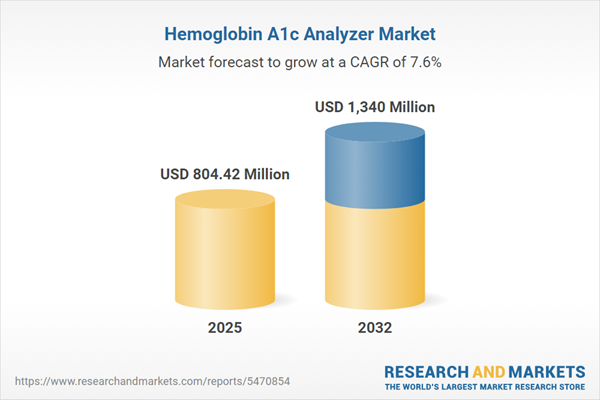Speak directly to the analyst to clarify any post sales queries you may have.
The Hemoglobin A1c Analyzer Market is undergoing significant transformation as healthcare demands and technological capabilities evolve, prompting new approaches to diabetes diagnosis and monitoring for clinicians, laboratories, and healthcare organizations seeking consistent, actionable insights.
Market Snapshot: Hemoglobin A1c Analyzer Market Growth and Drivers
The Hemoglobin A1c analyzer market is expected to experience steady expansion between 2024 and 2032, propelled by rising global diabetes prevalence, evolving clinical guidelines, and robust innovation in assay methods. With a compound annual growth rate that outpaces the broader diagnostics sector, this market signals strong ongoing demand from stakeholders seeking reliable, high-throughput, and increasingly accessible glycemic testing solutions.
Scope & Segmentation
- Product Types: Consumables, Calibration Kits, Quality Control Materials, Reagent Kits, Bench-Top Analyzers, Portable Devices, Data Management Software, Statistical Analysis Software
- Technologies Used: Boronate Affinity Chromatography, Direct Enzymatic Assay, Immunoassay (Enzyme and Turbidimetric Immunoassay), Ion-Exchange HPLC
- Testing Types: Laboratory Testing, Home Care Testing, Point-of-Care Testing
- Applications: Diabetes Diagnosis, Diabetes Monitoring, Health and Wellness Monitoring
- Distribution Channels: Medical and Diagnostic Laboratory Stores, Online Stores, Retail Pharmacies
- Regional Coverage: North America, Latin America, Europe, Middle East, Africa, Asia-Pacific, including markets such as United States, Canada, Brazil, Germany, United Kingdom, China, India, Japan, Australia, United Arab Emirates, South Africa, and others
- Reviewed Companies: Abbott Laboratories, ACON Laboratories, ARKRAY, Bio-Rad Laboratories, Danaher Corporation, Diazyme Laboratories, EKF Diagnostics Holdings, Hoffmann-La Roche, HORIBA, Tosoh Corporation
Key Takeaways for Senior Decision-Makers
- Increasingly, integration with electronic health records and statistical analysis platforms enables healthcare organizations to enhance operational efficiency and maintain data accuracy in glycemic monitoring workflows.
- Adoption of portable and point-of-care analyzers is accelerating, supporting remote care and decentralized testing—crucial for addressing rural health and facilitating broader diabetes screening programs.
- Advances in assay chemistries, calibration kits, and quality control materials reduce workflow variability, empowering laboratories to deliver dependable results and minimize downtime attributed to maintenance or quality drift.
- Segmentation reveals that consumables—reagent kits, calibration kits, and quality controls—anchor ongoing market demand due to their recurring use, while software solutions play a growing role in connectivity and compliance strategies.
- Manufacturer competition is intensified by supplier consolidation, innovation in reagent formulations, and emerging digital health collaborations, which are expanding the breadth of remote monitoring and patient engagement capabilities.
Tariff Impact on Imports and Supply Chains
New tariffs in the United States reshape sourcing strategies and heighten operating costs for manufacturers, calibration kit suppliers, and laboratory clients. These changes have prompted market participants to regionalize manufacturing, form new alliances, and adjust pricing models to mitigate disruptions. Enhanced focus on harmonized quality standards and agile procurement practices becomes essential for supply chain resilience, cost management, and uninterrupted access to essential diagnostic tools.
Methodology & Data Sources
This market research utilizes in-depth interviews with clinical, laboratory, and regulatory experts alongside rigorous secondary analysis of industry filings, scientific literature, and validated databases. Data were cross-verified and assessed by independent reviewers to ensure analytic rigor and objective insights suitable for strategic planning in the diagnostic devices sector.
Why This Report Matters: Strategic Value for B2B Leaders
- Enables informed decisions on technology adoption, product development, and operational improvements based on comprehensive segmentation and technology trends.
- Guides regional and global expansion strategies by outlining regulatory, reimbursement, and infrastructure variations across major healthcare markets.
- Equips stakeholders with actionable intelligence on supply chain risks, partnership opportunities, and emerging modalities within the Hemoglobin A1c analyzer ecosystem.
Conclusion
The Hemoglobin A1c Analyzer Market offers data-driven insight into clinical, technological, and regulatory trends shaping next-generation diabetes diagnostics. Senior leaders can leverage these findings to prioritize quality, innovation, and resilience within their strategic initiatives.
Additional Product Information:
- Purchase of this report includes 1 year online access with quarterly updates.
- This report can be updated on request. Please contact our Customer Experience team using the Ask a Question widget on our website.
Table of Contents
3. Executive Summary
4. Market Overview
7. Cumulative Impact of Artificial Intelligence 2025
Companies Mentioned
The companies profiled in this Hemoglobin A1c Analyzer market report include:- Abbott Laboratories
- ACON Laboratories, Inc.
- ARKRAY, Inc.
- Bio-Rad Laboratories, Inc.
- Danaher Corporation
- Diazyme Laboratories, Inc.
- EKF Diagnostics Holdings plc
- Hoffmann-La Roche Ltd
- HORIBA, Ltd.
- Tosoh Corporation
Table Information
| Report Attribute | Details |
|---|---|
| No. of Pages | 181 |
| Published | November 2025 |
| Forecast Period | 2025 - 2032 |
| Estimated Market Value ( USD | $ 804.42 Million |
| Forecasted Market Value ( USD | $ 1340 Million |
| Compound Annual Growth Rate | 7.6% |
| Regions Covered | Global |
| No. of Companies Mentioned | 11 |









